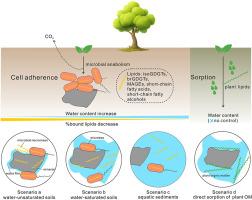土壤和沉积物中矿物结合的脂质形成:微生物途径的重要性
IF 10.3
1区 农林科学
Q1 SOIL SCIENCE
引用次数: 0
摘要
矿物保护是土壤有机质长期保存的重要机制。然而,矿物结合有机化合物的比例,在化学结构和生物起源上的变化,仍然不清楚,阻碍了对som -矿物相互作用机制的更深入理解。结构多样的脂类,如脂肪酸、四醚和脂肪醇,是反映植物和微生物起源的可缓慢分解的生物标志物,因此是探索有机矿物结合形成的良好指标。在这里,我们使用离线热解来量化不同含水量的水生沉积物(即湖泊和海洋沉积物)和土壤中的矿物结合脂类。不同的微生物脂质类型,如单烷基甘油醚(MAGEs)和支链脂肪酸,尽管它们的结构不同,但表现出相似的矿物质结合比例。与植物来源的脂质相比,这些微生物脂质通常显示出更高比例的矿物结合形式。这表明SOM的生物起源可能比化学结构在有机-矿物结合的形成中发挥更重要的作用。此外,在干燥条件下,结合微生物脂质比例较高,而结合植物源性脂质比例不受含水量的影响。我们将这种差异归因于微生物和植物脂质成为矿物结合的不同途径,因为在干燥条件下,微生物更有可能附着在矿物表面,促进有机矿物结合的形成,而植物有机质在初始分解后被吸附在矿物表面。这揭示了微生物对SOM稳定性的贡献,强调了微生物生理学,特别是亲水性(水导向运动),是SOM稳定的关键生物地球化学因素。本文章由计算机程序翻译,如有差异,请以英文原文为准。


Mineral-bound lipid formation in soils and sediments: the importance of microbial pathways
Mineral protection is the most important mechanism for the long-term preservation of soil organic matter (SOM). However, the proportions of mineral-bound organic compounds, varying in chemical structures and biological origins, remain unclear, impeding a deeper understanding of the mechanisms underlying SOM-mineral interactions. Structurally diverse lipids such as fatty acids, tetraethers, and fatty alcohols are slowly decomposable biomarkers reflecting plant and microbial origin and, therefore, are good indicators for exploring the formation of organo-mineral associations. Here we used offline pyrolysis to quantify the mineral-bound lipids in aquatic sediments (i.e., lake and marine sediments) and soils with varying water content. Diverse microbial lipid types, such as monoalkyl glycerol ethers (MAGEs) and branched fatty acids, exhibited comparable mineral-binding proportions despite their structural differences. These microbial lipids generally showed higher proportions in mineral-bound forms compared to plant-derived lipids. This suggests that the biological origin of SOM may play a more significant role than chemical structure in the formation of organo-mineral associations. In addition, the proportion of bound microbial lipids was higher under drier conditions, whereas the proportion of bound plant-derived lipids was not affected by water content. We attributed this discrepancy to the different pathways through which microbial and plant lipids become mineral-bound, as microbes are more likely to attach to mineral surfaces under drier conditions, facilitating the formation of organo-mineral associations, while plant organic matter is adsorbed on the mineral surfaces after initial decomposition. This sheds new light on the microbial contribution to SOM stability, highlighting microbial physiology, especially hydrotaxis (water-directed movement), as a crucial biogeochemical factor in SOM stabilization.
求助全文
通过发布文献求助,成功后即可免费获取论文全文。
去求助
来源期刊

Soil Biology & Biochemistry
农林科学-土壤科学
CiteScore
16.90
自引率
9.30%
发文量
312
审稿时长
49 days
期刊介绍:
Soil Biology & Biochemistry publishes original research articles of international significance focusing on biological processes in soil and their applications to soil and environmental quality. Major topics include the ecology and biochemical processes of soil organisms, their effects on the environment, and interactions with plants. The journal also welcomes state-of-the-art reviews and discussions on contemporary research in soil biology and biochemistry.
 求助内容:
求助内容: 应助结果提醒方式:
应助结果提醒方式:


